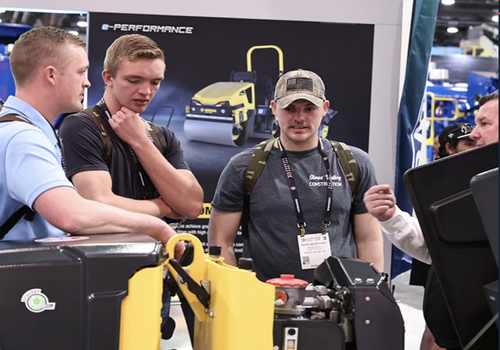Drum rollers are critical pieces of equipment in the construction industry, essential for compacting soil, asphalt and other materials to ensure a solid foundation for roads, buildings and infrastructure. Given their vital role, it’s crucial to maintain drum rollers properly to minimize downtime, enhance performance and extend their lifespan. Preventative maintenance not only helps in avoiding costly repairs but also ensures the safety of the operators and everyone on-site. Here are key tips and reminders for maintaining drum rollers effectively.
1. Daily Inspections: The First Line of Defense
A daily inspection is one of the simplest and most effective preventative maintenance steps. Operators should conduct a thorough walk-around inspection before and after each use. Key components to check include:
- Fluid Levels: Ensure engine oil, hydraulic fluid, coolant and fuel are at the appropriate levels. Low fluid levels can lead to overheating, reduced efficiency or even engine failure.
- Visual Check for Leaks: Look for any visible signs of fluid leaks, such as oil or hydraulic fluid, beneath the machine. Leaks can indicate seal or gasket failures that require immediate attention.
- Tire and Drum Condition: Inspect tires for proper inflation and damage, and check the drum for any dents, cracks or excessive wear that could affect compaction quality.
- Loose or Damaged Parts: Check for any loose bolts, fasteners or damaged parts, such as the scrapers, water spray systems or vibration mechanisms.
- Safety Features: Ensure that all safety devices, such as horns, lights, seat belts and emergency stops, are functional.
These quick inspections can prevent minor issues from becoming major problems and keep the drum roller in safe operating condition.
2. Keep It Clean: Regular Cleaning Practices
Keeping a drum roller clean may seem like a simple task, but it’s vital for preventing long-term damage. Dirt, mud and debris can accumulate in various components of the drum roller, leading to corrosion, overheating and reduced functionality.
- Clean the Drum Regularly: Remove any material stuck to the drum to prevent uneven compaction and to maintain optimal performance. Use water and a scraper, if necessary, to keep the drum free of debris.
- Check Air Filters: Dirty or clogged air filters can reduce engine efficiency and lead to overheating. Clean or replace air filters as needed to ensure adequate airflow to the engine.
- Clean Cooling Systems: Dust and debris can accumulate in the radiator and cooling systems, reducing their effectiveness. Regularly clean these components to prevent overheating.
3. Lubrication: The Key to Longevity
Proper lubrication is essential for maintaining the moving parts of a drum roller. Lubrication reduces friction, prevents rust and minimizes wear and tear.
- Grease Points: Identify all grease points on the machine, such as the drum bearings, pivot points and joints. Lubricate these areas regularly, following the manufacturer's guidelines.
- Hydraulic System: Check the hydraulic oil regularly and top up if needed. Use the recommended type of oil and change it according to the manufacturer’s schedule to ensure the system runs smoothly.
4. Follow the Manufacturer's Maintenance Schedule
Every drum roller comes with a maintenance schedule provided by the manufacturer. This schedule is specifically designed to maximize the lifespan of the equipment and should be strictly followed.
- Service Intervals: Regularly perform services such as oil changes, filter replacements and inspections according to the manufacturer’s guidelines. Adhering to these intervals helps prevent premature wear and failure.
- Professional Inspections: Schedule professional inspections and servicing periodically to ensure that all components are functioning correctly and to detect any hidden issues that may not be visible during daily checks.
5. Monitor Vibration Systems: Maintain Optimal Compaction Quality
The vibration system is critical to the effectiveness of a drum roller. Proper maintenance of this system ensures optimal compaction quality and extends the machine’s life.
- Check for Abnormal Vibrations: Regularly check for unusual noises or excessive vibrations, which could indicate problems with the vibration mechanism, such as a misalignment or worn components.
- Inspect Isolators: The isolators absorb vibration to protect the machine's chassis and operator. Inspect these parts regularly for wear and replace them as needed to maintain safety and comfort.
6. Maintain the Water Spray System: Prevent Material Adherence
For asphalt applications, drum rollers often have a water spray system to prevent material from sticking to the drum. Keeping this system in good working order is crucial.
- Check for Blockages: Inspect nozzles, hoses and filters for blockages that could reduce water flow. Clean or replace any clogged parts to ensure consistent spray coverage.
- Maintain Water Tank: Regularly inspect and clean the water tank to prevent algae and debris buildup, which can clog the system and reduce its effectiveness.
7. Storage: Protect Your Equipment from the Elements
Proper storage is essential, especially in harsh weather conditions. Exposure to moisture, extreme temperatures and direct sunlight can damage components over time.
- Store in a Covered Area: Whenever possible, store the drum roller in a covered area to protect it from rain, snow and sun exposure.
- Use Protective Covers: Use protective covers for the drum, tires and other vulnerable parts if indoor storage is not available.
- Prepare for Long-Term Storage: If the roller will not be used for an extended period, follow the manufacturer’s guidelines for long-term storage, such as draining fluids, disconnecting batteries and covering the machine.
8. Train Operators: Proper Usage Extends Lifespan
Operator training is a crucial aspect of preventative maintenance. Proper operation reduces the likelihood of unnecessary wear and tear and enhances the safety and longevity of the equipment.
- Train on Best Practices: Ensure that all operators are trained in the proper use of the drum roller, including safe operating speeds, correct use of the vibration system and how to avoid overloading the machine.
- Regular Refresher Courses: Conduct regular training sessions to keep operators up to date on best practices and maintenance procedures.
Preventative maintenance is a critical practice for extending the lifespan, ensuring safety and optimizing the performance of drum rollers. By incorporating these tips and reminders into your daily routine, you can prevent costly downtime, reduce repair expenses and keep your equipment operating efficiently for years to come. Remember, a well-maintained drum roller is a key asset on any construction site.
Photo credit: EDVAL/BIGSTOCKPHOTO.COM












